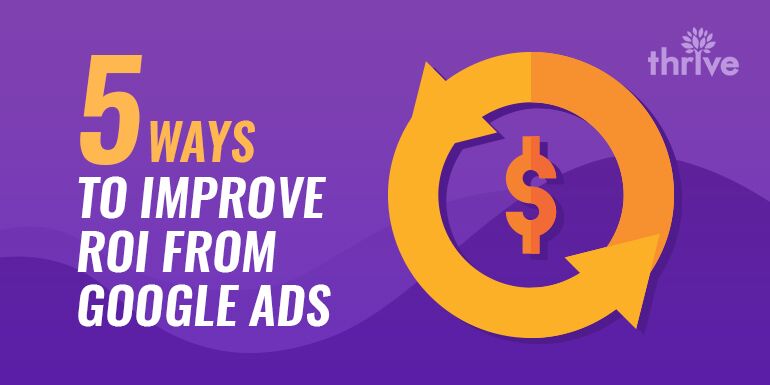Optimizing Google Ads with automated bidding on targeted keywords is an incredibly effective strategy for small to medium-sized businesses.
Getting a good return on investment for the keywords you bid on can seem like a complicated process, but these four tips will help you make the most of your Google Ads campaigns and clearly assess the outcomes.
5 Ways To Improve Google Ads ROI
Before we dive into each strategy, here are the five tactics we’ll be discussing here.
- Optimize by bids
- Automate high performers
- Use quality score to guide relevancy
- Structure keywords together
- Use seasonal targeting tactics
Optimize Google Ads By Bids Not Budget
While changing the budget of an ineffective PPC campaign may seem like the best option for more conversions, changing your bids is a far more effective strategy in most cases.
Target-based strategies, such as return-on-ad-spend (ROAS) and cost-per-acquisition (CPA) use automated bidding that controls your spending by adjusting your bids as needed. This has proven to be more effective than raising or lowering your budget to conform to these trends.
If you are in line with your Target CPA, which measures how much it costs you to earn a new client with each keyword, the algorithm reduces the target bid for you. If you are using Target ROAS, which measures how much you spend on each ad, increase your target number of conversions and your rate of spending will adjust accordingly.
The Google Ads algorithm will finally reach an average for your Target ROAS, allowing you to restrict the number of conversions for your campaign and save money.
Automate High Performing Ads
Automating advertisements that have high conversion rates can not only save time but increase your conversion rates as well. This practice depends largely on traffic volume for each keyword, and its use may vary depending on certain seasonal factors.
If your target keyword generates significant performance data that makes it easy to predict its performance in the future, automation is an easy process because the algorithm has plenty of information to do high ROI bidding. Ironically, things become more complicated if your keyword lacks data.
When the Google Ads system comes across a keyword with little performance data, its algorithm checks your group conversion rates as well as your campaigns to save time and confusion.
Use Quality Score To Guide Ad Relevancy
Quality score not only has a significant influence over the cost efficiency of search campaigns, but also helps determine ad rank. Unlike other search campaign metrics, several factors are involved in the 0-10 number score.
While its unknown exactly how much each factor is weighted, the indicators include expected click-through rate (CTR), landing page quality and relevance, relevance of keywords to ad groups they belong to, ad relevance, and historical Google Ads account performance.
Since relevance is the primary QS measure, start by checking your keyword organization. Keywords should be in specific groups and ted into individual ad campaigns. Within these groups, keywords need to be consistent with landing page content and should be constantly updated based on actual search terms. Negative keywords should be implemented to keep from wasting ad spend. Finally, ad text needs to be cohesive to keywords to provide a relevant consumer journey from search term to ad click to landing page.
Structure Keywords Together With Similar Conversion Rates
Structure keywords with similar conversion rates together when there is not a significant amount of data for one or more keywords.
This type of structuring is based on relevance as well, giving a more well-rounded metric to assess. Group structuring of keywords with similar conversion rates is good for automatic bidding because it provides a more reliable indicator of an individual keyword’s performance.
It is a good general practice to structure keywords according to conversion rates and other reliable factors, such as product lines or value. When the Google algorithm comes across a keyword without enough data, it will automatically check your ad group conversion rates and campaigns for context.
Otherwise, the individual keyword’s data is used to determine its bid.
Make Targets More Aggressive During Seasons
Automated bidding learns more as your account’s history develops, but it does not link your account history to specific seasonal events, such as Black Friday or Independence Day.
The algorithm used to determine account history prioritizes conversions made recently over more distant conversions. General seasonal conversion rate changes, such as sales increases before the holidays, do cause changes in the algorithm, but specific days do not.
If you want to target advertisements for holiday-specific sales, aggressive advertising is necessary to achieve an increased conversion rate on a specific day without increasing your bids on other days. You can also temporarily switch to CPA bidding for the one-day period that your advertisements are expected to generate extra traffic.
Targeted seasonal advertising is essential because Google’s algorithm is not calibrated to do this automatically. Businesses that want to stay ahead of the competition on a certain day without seeing a continual rise in cost should devote time to manually control bids on holidays and accommodate the inevitable spike in traffic.
Google Ads is a powerful and essential tool for online marketers in any industry, but its features are not always intuitive. By implementing these five strategies, you can see a better return on investment in your marketing campaigns.
Click here or call (866) 908-4748 for more tips on PPC and other search engine marketing.

